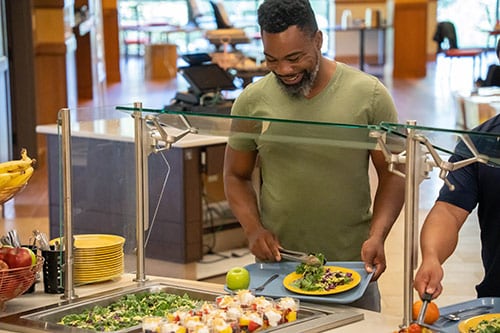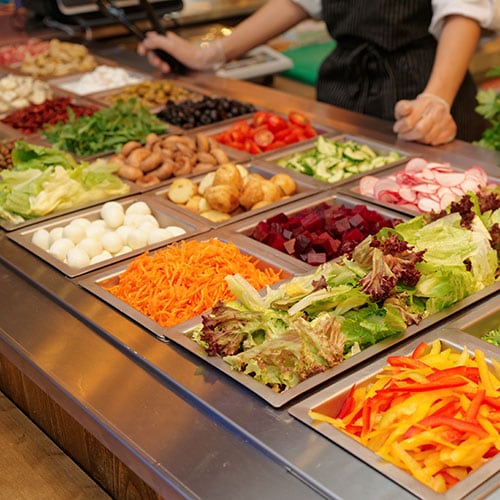
Apply Behavioral Design Strategies
Food service guidelines and behavioral design strategies are part of a comprehensive approach to promote health and wellness in worksites and other institutions. These strategies inform, enable, and encourage customers to select healthy items by ensuring that healthier menu and packaged food items are the default, normative, easy to access, and less expensive choice.
Many factors in the environment can influence a person’s actions and decisions when they are selecting, buying, and eating food. These factors include how foods are prepared, served, placed, presented, promoted, and priced. They also include the atmospherics of a space, which is affected by lighting, sounds, smells, and the overall design and layout.
Food service can use behavioral design strategies to create an environment where healthy options are the default (or preset) choice and are affordable and easy for customers to select. The feasibility and effectiveness of each strategy will vary depending on the food service venue and customer base, the combination of strategies chosen, and the specific way each strategy is used.3 Combining strategies from multiple categories can improve the overall influence of an environment on the behaviors and choices of customers.4,5
Behavioral design strategies can be used in worksite and community settings at local, state, and federal levels by public health practitioners, institutional and building managers, and food service managers. Food service operators can use behavioral design strategies to increase customer selection of healthier foods and beverages in cafeterias, micro markets, and vending machines.
The tools on this page can help you apply behavioral design strategies in your food service guidelines work. The tools include a description on how to use behavioral design, electronic checklists complete with sample diagrams with which you can assess your venue and plan your strategic actions, and a brief summary of the evidence.
Food service guidelines are standards for healthier food
and beverages and food service operations in worksite and community settings.
Behavioral design uses cognitive, emotional, behavioral, and informational strategies to direct people toward healthier choices.2
Behavioral Design Categories
The behavioral design standards in the Food Service Guidelines for Federal Facilities [PDF-3.3MB] are organized into six categories, which are listed below. See the Evidence for Behavioral Design Strategies to Encourage Healthier Food Choices section for a more detailed description and supporting evidence for each category.

- Placement and Layout: Strategically place foods and beverages and design the layout of food service venues to foster selection of healthier foods and beverages.
- Product Innovations and Defaults: Use product innovations and the inclusion of healthier options as default choices at decision points to encourage healthier choices.
- Pricing and Promotion: Use price incentives and marketing strategies to highlight healthier food and beverage items.
- Tableware: Promote healthy portion sizes by optimizing the size of plates, bowls, glasses, other dishware, and serving ware.
- Information: Use information, displays, decorations, and signage to highlight healthier choices.
- Organizational Policy: Adopt policies, practices, and programs that support a culture of health in your organization and encourage the use of food service guidelines and behavioral design standards in all onsite food venues.
The behavioral design strategies listed below can be applied to cafeterias, micro markets, and similar venues and to vending machines. Take an experimental approach to using behavioral design in food service venues. Try different strategies and different combinations of strategies. Consider ways to modify the examples provided for specific venues. The steps below can help you get started.
Steps to Using Behavioral Design Strategies

- Identify all food service operations in your building, company, or institution. Examples include cafeterias, micro markets, and vending machines, as well as areas where food is prepared or eaten, such as breakrooms.
- Click on the links to the checklists below to see examples of strategies.
- Behavioral Design Strategies for Cafeterias, Micro Markets, and Similar Food Venues [PDF-383KB]
- Behavioral Design Strategies for Vending Machine Operations [PDF-310KB]
- Click on the links to figures below, which generally illustrate strategies in specific venues. These strategies can be adapted to different venues as appropriate. For example, micro market strategies can be used in food kiosks, concession stands, snack bars, or sundry shops. Some cafeteria strategies can be used in congregate meal settings, such as in eldercare facilities.
- Deli Figure
- Grill Figure
- Cafe Seating Figure
- Salad Bar Figure
- World Cuisine Figure
- Micro Market Figure
- Vending Beverages Figure
- Vending Food Figure
- Consult or form a committee to focus on behavioral design strategies. If your organization already has a team working to implement and manage food service guidelines, it will be an ideal starting point to recruit committee members. This team may include public health employees, worksite wellness staff, facility managers and leaders, and food service staff. Using the appropriate checklist, the committee can meet at the relevant venue to:
- Determine which behavioral design strategies are already in use.
- Identify new behavioral design strategies to begin using now or use in the future.
- Compare the benefits of new strategies against the effort needed to use them and begin with the easiest strategies.
- Use multiple strategies that complement each other to accomplish goals. For example, customers may buy more fresh fruit if you:
- Place healthier items in the line of sight when customers enter the venue (Placement and Layout).
- Offer fresh-cut fruit in ready-to-eat containers (Product Innovations and Defaults).
- Offer discounts on items that are about to expire. For example, set the checkout machine to charge 50 cents less on Fridays for fruit that will be replaced over the weekend (Pricing and Promotion).
- Label food products that are locally sourced, certified organic, or produced through other certified community development or environmentally beneficial practice at the point of purchase (Information).
- Plan to continually introduce new strategies and new combinations of strategies. Monitor your efforts and outcomes and make changes as needed to improve the sale of healthy items. This approach will keep the consumer experience fresh. People adapt to changes, and the effectiveness of some behavioral design strategies or combination of strategies may fade over time.
- Make behavioral design strategies part of your ongoing monitoring and evaluation process. For guidance on how to evaluate your food service operations, see the Food Service Guidelines Implementation Toolkit or Smart Food Choices: How to Implement Food Service Guidelines in Public Facilities [PDF-3.47MB].
This section describes the six behavioral design categories in more detail and provides basic scientific evidence. The topics are presented in no order and should not imply rank. One category is no more important than another.
Placement and Layout
Approach and Examples
Strategically place foods and beverages and design the layout of food service venues to foster selection of healthier foods and beverages. This includes using equipment and serving ware to highlight healthy options. For example, you can:
- Make physical access to healthy items easier.
- Create flow paths that emphasize healthy items.
- Make healthy items more visible and
- Organize products to influence choice—for example, by putting healthy items first among two items or in the middle of three items.4
Evidence and Rationale
Placement and layout strategies can make selection an automatic process, reducing the physical and cognitive effort to making healthy choices. Decreasing the amount of working memory that a person needs to make a decision (called the cognitive load) can increase reason-based choice-making and lead to healthier choices.6,7 Research has shown that these practices can influence dietary choice, including increasing the consumption of fruits and vegetables and decreasing the consumption of sugar-sweetened beverages.8–11
Product Innovations and Defaults
Approach and Examples
Use product innovations and the inclusion of healthier options as default choices at decision points to encourage healthier choices. For example, you can:
- Use a variety of culinary and presentation styles and different combinations of offerings.
- Balance expected or traditional offerings with more novel items to maintain current customers and attract new ones.
- Offer smaller portion size options and provide smaller serving ware.
- Normalize easy access to healthier items—for example, by putting only healthy items by the cash register or checkout machine.
- Make healthy options the default choice in menus, lists, sales, and bundles.
Rationale and Evidence
Providing customers a high-quality product and experience is an important part of selling healthier foods. Product and service innovation is a key to this effort. In turn, satisfaction with worksite food quality increases the general well-being of employees.12
Offering healthier foods that are in demand, including those that follow market trends, is a safe way to introduce new products at low financial risk. Evidence is mixed on the ideal number of offerings or the ideal ratio of healthy to less healthy offerings. However, studies have generally found that people choose healthy options more often when there is a larger number and variety and relative availability of healthy products.10,11,13
Smaller portions, servings, and tableware can lead customers to choose smaller options.14 However, food service operators must pay attention to outcomes when adjusting portion sizes because the largest and smallest sizes tend to be the least selected.15
Default or preset options simplify decision-making.16 In food service settings, this approach can include bundling meals with healthy sides and beverages. By reducing the need to make decisions, default options reduce cognitive burden and make healthy choices easier and more likely.17
Pricing and Promotion
Approach and Examples
Use price incentives and marketing strategies to highlight healthier food and beverage items. Examples include financial incentives such as discounts, vouchers, coupons, rebates, bundling, and price comparisons to encourage healthy food choices. The goal is to make it easier for customers to afford healthy foods.
Rationale and Evidence
Economic incentives can influence health behaviors even against behavioral and cognitive tendencies. The price of food is a primary determinant of consumer purchasing decisions.18 Research has shown that price reductions can increase consumer demand and consumption of healthier foods.19–24 For example, food pricing and consumption studies in cafeterias, vending machines, and supermarkets found that a price decrease of 10% would lead to an overall increased consumption of healthy foods by 12%.25 For fruits and vegetables, an average 10% decrease in price led to a 14% increase in consumption.25,26
Price increases may also reduce consumption of less healthy products, such as sugar-sweetened beverages.9 One study found that a 10% increase in the price of unhealthy foods lead to a 6% decrease in consumption of these items.25
Price discounts have also been found to increase purchasing of healthy foods in workplace environments.27 However, these incentives are not equally effective for all products or in all venues, and their effect may vary according to customer demographics.
Tableware
Approach and Examples
Promote healthy portion sizes by optimizing the size of plates, bowls, glasses, other dishware, and serving ware. These strategies can be used to increase the portion size of healthy foods or decrease the size of less healthy foods.
Rationale and Evidence
Many studies have found that people eat and drink more when portion sizes are larger, which can lead to increased calorie intake.28 Portion size and the amount consumed are influenced by individual, cultural, and environmental variables, one of which is the size and shape of the tableware and serving ware.14,29,30
The dominate mechanism through which tableware influences consumption is that the size of the tableware distorts perceived portion size, leading to larger servings being added to larger tableware.31 Perception of liquids is slightly different. People have more difficulty estimating the volume of liquids in glasses that are wider and shorter vs narrower and taller, which can increase the amount consumed from wider and shorter glasses.32
Many studies have explored how tableware and serving ware influence portion size and overall consumption. These studies have generally found a small but consistent effect when size and shape are modified, with larger tableware increasing the selection and intake of healthier foods and smaller tableware decreasing the selection and intake of less healthy foods.14,32,33 However, these strategies have been found to be most effective in self-service settings.32
Advantages of these strategies are that they are time and cost neutral, they help create transferable normative behavior, and they are not invasive.34
Information
Approach and Examples

Use information, displays, decorations, and signage to highlight healthier choices. These strategies focus primarily on where and how to display factual information designed to encourage or provide a rationale for healthier selections. This information can be displayed through menus, labels, advertising, demonstrations, or other types of messaging.
These strategies inherently include design elements—such as color, size, positioning, styling, sounds, and smells—that may influence a person’s general experience (both alone and in combination) and, in turn, their behavior. These design elements are classified in an additional behavioral design category referred to as atmospherics, which will be addressed in future guidance documents.
Rationale and Evidence
Information strategies influence dietary behaviors by communicating factual associations between dietary choices and health or performance outcomes. Behavioral outcomes are influenced by the content and context of messaging efforts. For example, food and nutrition information displayed on menus, labels, or signs can influence customers’ knowledge of portion size and nutritional quality and may influence food purchasing and consumption.9,35,36
These strategies may lead to healthier food and beverage selection and better understanding of how food and food systems affect individual health and social and ecologic outcomes.37,38 They include nutrition labeling, menu design, food and nutrition literacy, and signage.
- Nutrition Labeling. Labeling foods with information about nutritional value, health potential, or how the product was sourced or produced can increase its selection.36,39–42 For example, labels that use traffic light colors (green, yellow, and red) to rate the healthiness of foods and beverages may help people choose healthier foods and drink fewer sugar-sweetened beverages.9,43 Several international health organizations recommend front-of-package (FOP) labels as a way to influence dietary behavior and provide product transparency.44
In the United States, the US Food and Drug Administration (FDA) does not require FOP labels, but notes that “FOP or shelf labeling that provides consumers with readily accessible information about a product’s nutritional profile, in a manner that is consistent with and linked to the required Nutrition Facts panel, responds to today’s marketplace realities and can be part of the education and outreach consumers need to understand and act on nutrition information at the point of purchase.”45
FDA cautions that FOP labels may lead to people being less likely to check Nutrition Facts panels on food packages. It also notes that, while nutrition-related FOP labeling is voluntary, it is subject to the provisions of the Federal Food, Drug, and Cosmetic Act, which prohibit false or misleading claims and restrict nutrient content claims to those defined in FDA regulations.
- Menu Design. The layout and design of physical menus and electronic ordering systems can influence food and beverage purchasing. This includes the relative positioning of items on a menu, the default appearance of items in electronic menus, and the use of pictures of healthy food. 26,46–49
- Food and Nutrition Literacy. Food and nutrition literacy strategies seek to increase skills and knowledge about foods (such as preparation, tasting, cultures, and systems), including how dietary choices influence social, economic, and ecologic outcomes.50–52
- Signage. Signs can encourage people to select healthier food items by drawing attention to products, creating flow paths, communicating factual information, and showing inspirational images, such as nature scenes or people being physical active.53,54
Organizational Policy
Approach and Examples

Adopt policies, practices, and programs that support a culture of health in your organization and encourage the use of food service guidelines and behavioral design standards in all onsite food venues. These strategies use institutional authority and management processes—such as leadership, worksite wellness programs, and employee organizations—to create policies, practices, and programs that promote environments where healthy choices are the default option.
These strategies may take different approaches depending on your organization’s goals, values, and demographics. For example, if your organization is overtly committed to health and wellness and has a top-down management structure, you can use mandates, written policies, and intensive monitoring to achieve your goals. Alternately, if your organization has a more relaxed management style and no overt commitment to health, you may simply provide education and guidance on food venue contracts, spaces, and informational materials, without mandates or contractual requirements.
There are two overall ways to use organizational policies to promote healthier outcomes:
- Agent- or individual-focused approach. This approach is designed to support intentional, rational decision-making by individuals. It relies on individuals to actively incorporate messages into their decision-making processes. Examples include FOP labeling, social marketing, and media campaigns.
- Ecologic or environmental approach. This approach is designed to make it easier, unavoidable, default, or normative to make healthy choices or take healthy actions. It requires little or no effort from individuals. Instead, it requires societal commitment and cultural acceptance to change the shared environment. Examples include fluoridation of community water systems, fortification of grains, or the use of healthy food service guidelines.1,55
Rationale and Evidence
Organizational policies have been used successfully to improve food and nutrition quality and influence the dining and food selection experience in many types of institutional settings, including schools, universities, private and government worksites, hospitals, recreation facilities, and parks.56 Local, state, and federal governments and the World Health Organization use and recommend the use of food service guidelines as a public health policy approach.57
Policies that focus on improving health can have both direct and indirect benefits. For example, in addition to helping individuals eat a healthy diet, healthy food service options in the workplace can improve productivity and satisfaction among employees, especially when quality food is offered in a pleasant setting. It may also encourage people to make better dietary choices outside the workplace.12,58
To succeed, policies intended to improve health need to include cognitive and behavioral approaches in their content, design, and focus.59,60 These approaches can help clarify expectations around how and when a policy will achieve its goal.